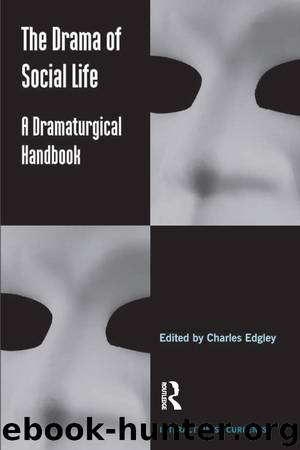The Drama of Social Life by Edgley Charles

Author:Edgley, Charles.
Language: eng
Format: epub
Publisher: Taylor & Francis (CAM)
Published: 2013-04-14T16:00:00+00:00
The Street as Stage and Staging Area
As a site for the production of both legitimacy and discreditation, intrusion into the greenroom by police may reveal practices or resources on the part of protesters that are questionable, deviant or illegal. Conversely, intrusion into private space that is constitutionally guaranteed may not only result in the discrediting of police claims concerning protesters as terrorists, but also lead the public to question the legally sanctioned role of police on the street. This latter definition of police activity came to be sustained by both protesters and the public, eventually culminating in lawsuits against police that were won by activists (Furst 2011).
If the greenroom is a primary venue for legitimating and discrediting performances, so certainly is the street. As theater for political performances, the street is spatially arranged by police and protesters as both a stage and set of “staging areas.” As Benford and Hunt (1992:43) define the term, “Staging refers to appropriating, managing and directing materials, audiences and performing regions.” Staging commonly precedes protest activity and entails the management of organizational details that comprise that activity. A staging area is that space from which protest activities are launched and directed. The actual “stage” in a demonstration includes the area where planned protest takes place—transforming parks, parking lots, streets, store fronts, café counters, or shop floors into “performative space.” However, it is important to note that some activities on the street are not formally organized as part of demonstrations but constitute improvised performances.6 Skirmishes between police and protesters, riots, and street rebellion, may emanate from organized demonstrations and serve as important performances in their own right. As Benford and Hunt (1992:45) explain:
Performing involves the demonstration and enactment of power. It concretizes ideas regarding the struggle between protagonists and antagonists and reveals to audiences ways they can achieve or preserve desirable power relations. Furthermore, performing is itself empowering. By taking action to alter or sustain power arrangements, movement participants experience a transformation of self, moving from a person who is acted upon by external forces to an agent actively shaping the scene.
Once out on the streets of St. Paul, contained protesters could be seen making noise, chanting slogans, using signs, pickets, and puppets in street theater, and/or dressing flamboyantly to attract attention.7 Such activity represented a “structured protest” (Piven and Cloward 1979), as demonstrators followed a blueprint for protest that was prearranged by the march permit. On the global stage, peaceful protesters sought to communicate the legitimacy of their cause by creating images in which they might be seen as peaceful, law-abiding protesters. On the street, “contained” or peaceful protesters hoped to neutralize any justification for police repression by virtue of the fact that they were acting in accordance with the pre-arranged march permit, making their actions both intelligible and predictable to state authorities. That the state had effectively “colonized” dissent through peaceful means was a dimension not lost on these same protesters. In describing her experience of being corralled into a protest pen that police
Download
This site does not store any files on its server. We only index and link to content provided by other sites. Please contact the content providers to delete copyright contents if any and email us, we'll remove relevant links or contents immediately.
Rewire Your Anxious Brain by Catherine M. Pittman(18552)
Talking to Strangers by Malcolm Gladwell(13222)
The Art of Thinking Clearly by Rolf Dobelli(10219)
Mindhunter: Inside the FBI's Elite Serial Crime Unit by John E. Douglas & Mark Olshaker(9200)
Becoming Supernatural by Dr. Joe Dispenza(8119)
Change Your Questions, Change Your Life by Marilee Adams(7635)
Nudge - Improving Decisions about Health, Wealth, and Happiness by Thaler Sunstein(7615)
The Road Less Traveled by M. Scott Peck(7522)
The Lost Art of Listening by Michael P. Nichols(7406)
Enlightenment Now: The Case for Reason, Science, Humanism, and Progress by Steven Pinker(7228)
Mastermind: How to Think Like Sherlock Holmes by Maria Konnikova(7227)
Win Bigly by Scott Adams(7094)
The Way of Zen by Alan W. Watts(6505)
Daring Greatly by Brene Brown(6444)
Big Magic: Creative Living Beyond Fear by Elizabeth Gilbert(5610)
Grit by Angela Duckworth(5521)
Ego Is the Enemy by Ryan Holiday(5294)
Men In Love by Nancy Friday(5155)
Altered Sensations by David Pantalony(5045)
